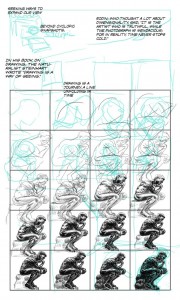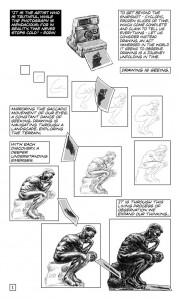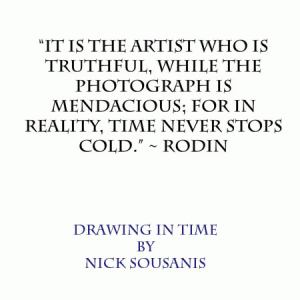Catching up from my conference trip a couple weeks back (which ended up being six talks in six days after a last minute invitation to join Anna Smith & company for a session at AERA on emerging literacies research methods, which was a really cool and generative discussion).
The trek included a few solo discussions of my dissertation work, a session I put together comprised of other folks doing research in and around comics, and a session I was invited to participate on the use of comics as a form of research. (I posted a few reflections on HASTAC’s blog here. And comics researcher Paul Kuttner, who was in attendance at the comics as research session, wrote some thoughts about it on his blog here.)
Over the last few years, having to organize my thoughts in short windows of time in front of an audience has been extremely instrumental in formulating just what I’m up to – shaping my work as I’m making it. Despite being well into the dissertation at this point, this recent week of travel was no less significant in furthering my thinking. Particularly resonant was a point raised in response to the AERA session around comics as research by a senior prof in arts-based research about “aesthetics equaling analysis.” Those three words perfectly articulated what I’m up to – or at least the approach I try to bring to my work.
Let me explain a bit. In a broad sense, my work sets out to ask what possibilities for discovery are we missing when we restrict ourselves to a single mode, specifically the verbal? In the process of exploring this larger goal of expanding the forms academic inquiry can take, I need to demonstrate comics are indeed legitimate for conducting scholarly research. To this end, I see it as imperative to take an “amphibious” approach – that is not image illustrating text, but fully integrating visual alongside verbal – making full use of the different capacities for expression this form possesses that exceed what can be done by traditional means. And so returning to the salient point raised: in my work aesthetic concerns and analysis equally inform one another, such that form and meaning are woven into an inextricable union. It is here, in this joining of form and meaning, of aesthetics and analysis, that I feel we can create spaces from which to generate new possibilities for understanding.
So, had I done this dissertation in text only, it would not only be discernible from what I’m doing in comics because of the lack of images, but because its entire flow and shape would be something else altogether. I’ve got ideas I want to explore, but their ultimate expression is paying heed to the feedback between form and content and doing my best to hold on and follow where they take me. Making the work teaches me where I need to go and its visual form is never a secondary pursuit.
I thought I’d share an old piece, that somewhat speaks to this. A page from “Mind the Gaps,”which is in the book “Narrative Inquiry.” Here, the idea to show a drawing evolving in time was too dense for the page as I’d had in mind (with 25 different stages of drawing), so in paring it down, a different means of expressing it emerged. Prompted by a conversation with my good friend and Game Show NYCcollaborator Andy Malone, I recently thought to animate the original 25 sketches and share them here as a rare bit of animation in this space.
Also, in the conversation with the super cool people of the Stanford Graphic Narrative Project, I was asked about how I was planning to undertake the dissertation’s abstract, bibliography, and acknowledgments. While I’d had fleeting thoughts about approaching these as the rest of the work, that had been on the back burner. But this conversation ignited renewed interest in making sure that the form of these elements was as fully conceived of as the rest of the work. Again – aesthetics equals analysis and form informs content. All in all, a productive trip to say the least!
And with that, back to drawing! Working on the longish, final sequence to Chapter Three. More soon – Nick





